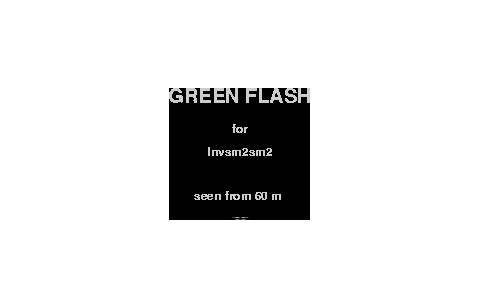

The green flash produced here as the neck of the hourglass breaks is hardly ever seen in practice, because it is so dim. The neck is usually drowned out by the bright main image below it, and the bright yellow “plume” above; so only the final green of the disappearing plume is well enough separated from the brighter main image to be noticed. The brightness of the flash is exaggerated in this simulation; I have more realistic simulations of such flashes, but they are not animated.
Mila Zinkova has photographed such an “hourglass” flash — though under unusual circumstances. Her very compressed solar image was seen through a relatively short duct, as the superior mirage of the land to the right of the Sun in a later picture of this sunset shows. The two lines at the horizon in that second photograph are each a double image of the whole Sun; each is an extreme mock mirage due to a strong inversion just above the sea surface. The shortness of the duct allows the Sun to be seen through it, rather than being blocked by Wegener's blank strip as one would normally expect.
The green flash seen as the plume vanishes in the simulation is actually a magnified image of the green rim, produced at the bottom of the thermal inversion. The simple model shown here illustrates the formation of these common mock-mirage flashes. Notice how far below the astronomical horizon the flash is; this is typical of a mock-mirage flash.
This simulated flash was produced by a weak thermal inversion. If the inversion is much stronger, so that the observer looks down through a duct, quite a different set of phenomena can be seen.
© 1999 – 2002, 2005 – 2008 Andrew T. Young